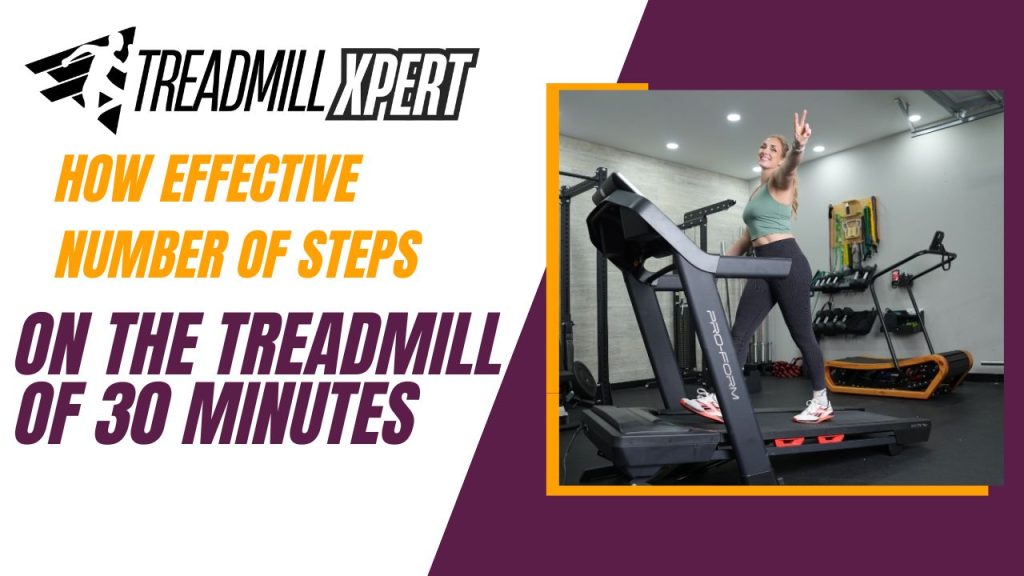Effective Number of Steps of 30 Minutes on a Treadmill
Tracking the number of steps taken during a 30-minute treadmill session is an effective way to monitor your fitness progress. The exact step count can vary depending on several personal and treadmill-based factors. This guide will explain how to estimate, calculate, and understand the effective number of steps in 30 minutes on a treadmill.
How to Calculate Number of Steps on the Treadmill
Before estimating your steps, you’ll need your average stride length and walking speed:
-
Measure Stride Length:
-
Walk 10 steps and measure the total distance in feet.
-
Divide the distance by 10 to find your average stride length.
-
-
Check Treadmill Speed:
-
Use the treadmill’s display to find your walking speed in miles per hour (mph).
-
Use the Formula:
Steps = (Walking speed in mph x 5280 ft/mile) / (Stride length in ft x 2) x 30
Example Calculation:
-
Walking speed: 3 mph
-
Stride length: 2.5 ft
-
Steps = (3 x 5280) / (2.5 x 2) x 30 = 7920 / 5 x 30 = 396 x 30 = 11,880 steps
This formula gives a solid estimate. However, actual results can vary due to other factors.

Key Factors Affecting Step Count
-
Walking/Running Speed:
-
Faster speeds increase step rate.
-
At 2 mph, expect ~2,500 steps; at 3 mph, ~3,000 steps; at 4 mph, ~4,000 steps in 30 minutes.
-
-
Incline:
-
Higher inclines increase the number of steps needed to cover a distance.
-
You burn more calories and take more steps at a higher incline.
-
-
Stride Length:
-
Longer stride = fewer steps.
-
Shorter stride = more steps.
-
-
Fitness Level:
-
Fitter users may have longer strides and better running economy, resulting in fewer steps.
-
Beginners tend to take shorter, more frequent steps.
-
-
Weight:
-
Heavier individuals may naturally have shorter strides, resulting in more steps.
-
-
Age:
-
Older adults may take shorter strides, increasing step count.
-
-
Gender:
-
Men typically have longer stride lengths, leading to fewer steps.
-
-
Arm Swing and Posture:
-
Vigorous arm swing can improve stride length.
-
Tips for Estimating Steps in 30 Minutes
-
Use a Fitness Tracker:
-
Devices like Fitbit or Apple Watch offer accurate step counts.
-
-
Check the Treadmill Display:
-
Some treadmills show real-time step counts based on your input and walking speed.
-
-
Use the Fitness Formula:
-
Estimate: Walking speed (mph) x 133 = steps per minute.
-
At 3 mph: 3 x 133 = 399 steps/min
-
Over 30 minutes: 399 x 30 = 11,970 steps
-
-
Manual Method:
-
Count steps for 10 seconds, then multiply by 6 for steps per minute.
-
Multiply that by 30 to get your 30-minute total.
-
-
Video Yourself:
-
Record one minute of walking. Replay and count the steps to calculate an accurate per-minute rate.
-
Summary Table: Estimated Steps in 30 Minutes
| Walking Speed | Estimated Steps | Notes |
|---|---|---|
| 2 mph | ~2,500 | Leisure pace |
| 3 mph | ~3,000 | Moderate pace |
| 4 mph | ~4,000 | Brisk walking |
| Jog/Run | 5,000+ | Varies by stride and speed |
📊 Average Steps per Minute
The average number of steps per minute can differ based on walking speed:
-
2 mph (slow pace): Approximately 60 steps per minute
-
3 mph (moderate pace): Approximately 80 steps per minute
-
4 mph (brisk pace): Approximately 100 steps per minute
These figures are general estimates and can vary based on individual stride length and walking mechanics.

🧍♂️ Factors Influencing Step Count
Several factors can influence the number of steps taken during a 30-minute treadmill session:
-
Stride Length: Individuals with longer strides will take fewer steps to cover the same distance compared to those with shorter strides.
-
Incline: Walking on an incline can increase the number of steps due to shorter stride lengths and increased effort.
-
Fitness Level: More conditioned individuals may have more efficient strides, potentially affecting step count.
-
Body Mechanics: Posture, gait, and walking form can influence stride length and frequency.
📱 Tracking Steps Accurately
To monitor your steps accurately during treadmill workouts:
-
Use a Pedometer or Fitness Tracker: Devices like Fitbit or Apple Watch can provide real-time step counts.
-
Treadmill Display: Many modern treadmills display step count alongside other metrics.
-
Mobile Apps: Applications like Stride kick can help track steps and distance.
🏁 Setting Realistic Step Goals
While the commonly cited goal is 10,000 steps per day, individual targets may vary based on personal health objectives. A 30-minute treadmill session can contribute significantly toward this goal, especially when combined with other daily activities.
Conclusion
The effective number of steps of 30 minutes on a treadmill depends on a combination of speed, stride, incline, and user-specific factors. While 3,000 steps at a moderate pace is a good average, tracking with a fitness device or using the formula will provide a more personalized result. The more consistent you are with your walking or running routine, the better your estimates will become.
READ MORE:
-
A Treadmill Make Your Bum Smaller
-
Walk on the Treadmill Without Holding the Handrails
